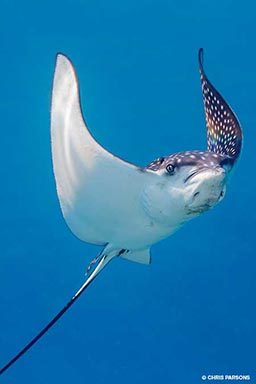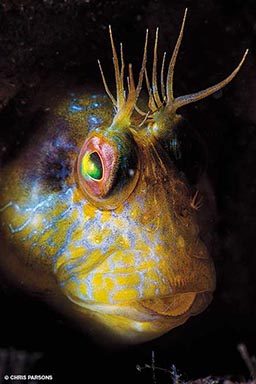Twice each day, the moon and sun conspire with the warm Gulf Stream to push clean, clear water to a dive site known as Blue Heron Bridge. Carried along in these currents is an amazing variety of underwater creatures, and we in South Florida are extremely fortunate to have this place in our backyard.

You may hear the site referred to as the Blue Heron Bridge, BHB or Phil Foster Park, but most local divers simply call it “the bridge.” This place, located in Riviera Beach, Fla., has become well known for the wide diversity of unique macro photo subjects that thrive in its waters, though one doesn’t need to be a photographer to enjoy it. It is not unusual to see open-water dive classes here alongside a cadre of dedicated underwater photographers.

Part of the bridge’s allure is the ease of the diving there. It is a beach entry, and there’s rarely more than a ripple in terms of waves, even if a hurricane is blowing offshore. BHB is generally done as a shore dive; the beach is smooth, gently sloping sand. I routinely dive with full-foot fins and never think twice about walking barefoot into the water.
Listing all of the creatures found at BHB would take all day, but commonly seen marine life includes three types of octopus (even during the day), mantis shrimp, starfish and many types of crabs, including box crabs, neck crabs and several varieties of hermit crab. While not actually a crab, the extremely weird and cool horseshoe crab is a “living fossil”; these are easily seen at the BHB by keeping an eye on the sandy areas.
Other fairly common local creatures that make good photographic subjects are batfish, sea robins, flying gurnards, stargazers, eels and at least three species of fireworm. There are also at least three species of jawfish here, and it’s not uncommon to find a mouth-brooding male taking care of its eggs. There are other creatures that take a little more work to find; these include seahorses, skeleton shrimp, squat shrimp, bumblebee shrimp, frogfish, pipefish, pike blennies, tiny nudibranchs and nightmarish Bobbit worms. The most interesting thing about the bridge is that you never know what you are going to find next.

There are really two separate dive sites at BHB, and though you could do them both on the same dive, you wouldn’t want to. Finding the interesting cast of characters takes a slow and patient approach. For people new to BHB I recommend diving the east side, or “little bridge,” first and then trying the west side (“big bridge”) once they’re more familiar with the area. The west side is typically shallower than the east and features larger bridge pilings. The east side is where divers will find more structure, including more (but smaller) bridge pilings, along with the wrecks of two powerboats, a sailboat and a large section of dock. These wrecks are not really destinations in themselves, but they do provide habitat and photo opportunities.
When you first enter the water, the landscape is featureless sand; as you get farther along you’ll come to areas with more rubble as well as some scattered grassy areas. The small wrecks can hold a lot of interesting small subjects such as blennies and banded coral shrimp. It can take a while for the eyes to adjust to “muck” diving, but this site usually rewards patient divers with interesting finds.
In 2012 Palm Beach County installed what is now referred to as the snorkel trail — an 800-foot-long collection of rock and concrete designed as an artificial reef. The snorkel trail has already begun to attract growth, and it’s definitely worth a visit. It runs east to west parallel to and about 150 feet south of the beach. For divers it’s not only a good place to see fish and other creatures, it also serves as a handy waypoint for navigation. It is generally advisable not to venture to the south of the snorkel trail as that would put you too close to an active boat channel.

Unfortunately, there are more plans for changes to the area. A permit application for an expansion of the Port of Palm Beach was approved and subsequently withdrawn by the U.S. Army Corps of Engineers in June 2014. The withdrawal is definitely not the end of the project, however. There is a strong push to expand the inlet, and some people speculate that the withdrawal of the permit was done to make the application stronger (i.e., more likely to meet all requirements for approval). A reading of the first permit application indicates no consideration for the impact on the BHB habitat. There is little doubt that the environment and the diving at the BHB would be significantly affected, but those considerations do not seem to be high on the priority list in terms of the project’s approval.
How To Dive It
Pura Vida Divers offers guided dives with top-notch local guides, something that is highly recommended for BHB first-timers. Reef Photo and Video operates photography classes at BHB several times a year for people wanting to improve their underwater photography or videography skills. (The author is one of the instructors of these classes).

Dives need to be properly timed with the currents. A rule of thumb that works pretty well is to enter the water about 45 minutes to an hour before high tide, which occurs twice a day. The current will be running north at that time. The slack current will happen about a half hour after the high tide, and that typically represents the best visibility and least amount of current. Shortly after slack, the current will begin to move to the south, and the visibility will then begin to deteriorate.
While the current can be zippy, there is a lot of available structure to hide behind. Good spots for finding an eddy include the bridge pilings, the wrecks and the snorkel trail.
The depth here averages only about 15 feet, so while a typical dive day here involves only one dive, it may be a two-hour affair or even longer. There is boat traffic in the area, so divers need to know where the boat channels are. Also be aware that Florida has a state law governing the display of dive flags or buoys and the responsibility of boat traffic in the area.
Getting There: The closest airports are Palm Beach International (PBI) and Fort Lauderdale-Hollywood International (FLL). Riviera Beach is located just north of West Palm Beach, and there are plenty of places to stay nearby. A number of dive shops in the area rent gear; these include Pura Vida Divers, Jim Abernethy’s Scuba Adventures and Force-E Divers. Talk to the shop staff about the Florida dive flag rules and boat traffic, and, if you like, inquire about diving the excellent offshore sites as well.

Conditions: While there is a seasonal aspect to the diving, BHB is actually very good year round. The site is so well protected that it’s diveable even when conditions offshore are far too rough for diving. The water temperature in the summer gets up into the mid-80s°F and can dip down to around 70°F in winter.
The visibility changes every day, but it’s typically 30 to 60 feet. Occasionally it will reach 100 feet, but it can also drop down into the single digits. The visibility tends to be worse after a heavy rain or when the engineers at Lake Okeechobee decide to draw down the lake level.
Parking can be hard to find on summer weekends, but generally weekdays are much less crowded. The park is not open 24 hours a day, so make sure you plan your dive so you can exit the park prior to closing time. Night dives are possible — inquire at the dive shop about getting a permit for night diving.
On the Surface: From alligator wrestling to beautiful beaches to Miami’s South Beach nightlife, South Florida is teeming with things to see and do. If you want to stay close to the bridge, check out the scene in West Palm Beach’s Clematis Street and waterfront areas.
In 1961 U.S. Navy Seabees constructed an underground bunker for President John F. Kennedy on Peanut Island, located just across the channel from the Blue Heron Bridge. Today you can tour the bunker and see where the president may have been evacuated had the Cuban Missile Crisis turned out differently. If snorkeling, swimming, hiking or camping is more your thing, the rest of Peanut Island Park is a calm little oasis in the middle of the busy Port of Lake Worth.
© Alert Diver — Q1 Winter 2015